In this guide, we’ll help you identify and locate water leaks in your home, making the process simple and straightforward.
We’ll cover potential water sources and explain how to detect leaks using visual signs, such as water stains on walls or pooling in your basement. By understanding these indicators, you’ll be able to pinpoint the origin of the leak effectively.
Use a Damp Meter to Locate Water Leak Areas
Suspect a water leak due to damp or cold spots on your wall? Confirm it with a damp meter or surface thermometer.
These tools help identify damp areas, even if they’re not immediately visible. If you can’t access these devices, use the back of your hand to detect cold or damp spots on walls, floors, or ceilings.
A damp meter is very straightforward to use: insert the prongs on its base into the walls surface and the display will tell you if damp is present and to what levels.
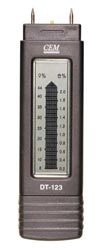
Use a damp meter like this one to find the area of your wall or ceiling affected by the leak
You can also use a hygrometer to check the air’s moisture content. This helps determine if condensation, rather than a hidden leak, is causing the damp patches.
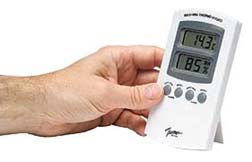
A hygrometer measures the dampness of the air inside your house – a high reading may indicate that condensation is the issue rather than a water leak
Water Leak Detection Checklist
If you have confirmed the presence of damp, the next step is to locate the actual cause so that you can then repair it and stop the issue. Work through the checklist below and hopefully this will help you pin-point the source.
1. Leaking Mains Supply
A water leak might be from your mains water supply or even from a neighbour’s property.
Leaks from a water main further up the road can also cause basement flooding, if this is where your issue resides.
Contact your water supplier to check your mains supply and your neighbours’ supply. Only neighbours beside you or uphill can affect your property.
2. Test Water
If water has seeped through your walls, floor, or into your basement, your water supplier can test it to identify its source.
They can determine if it’s groundwater, mains water, or sewage.
Find your local water supplier on Water UK’s website.
3. Leaking Foul Water Pipes
To check for leaks in your foul water pipes, start by blocking them.
Identify where your foul water drains by turning on a tap and lifting your manhole cover.
Use a 4-inch or 6-inch bung from your local builders’ merchant to block the drain outlet in the manhole.
Fill your toilet bowl or sink with water and mark the water level. Leave it overnight.
If the water level drops by morning, you likely have a leak and should contact a drains company for inspection and repair.
Find a qualified drainage expert on the National Association of Drainage Contractors website.
If you suspect the leak’s location based on wet areas, you may already know what needs fixing. Remember to remove the bung after testing!
4. Using Dye to Test for Leaks
To check for leaks in your surface drain, use drain testing dye available at your local builders’ merchant.
Add the dye to the drain and fill it with water. The dye glows in the dark, so inspect the leak at night. If you see the dye, the water is coming from your surface drain.
5. Check Fittings and Appliances
If water is leaking into your bathroom or kitchen, inspect your plumbed appliances, bathtub, shower, sink, and toilet.
Leaks in a room are usually caused by faulty appliances (washing machine, dishwasher) or fixtures (bath, shower enclosure).
While the appliance is running or the fixture is in use, thoroughly check for any signs of leaks.
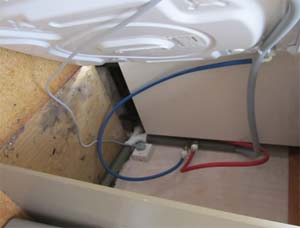
Appliances are a likely source of water leaks in your kitchen or bathroom
6. Check Central Heating System
If you notice water on your floor, your central heating system might be leaking.
Inspect your pipes and radiators, especially the pipes under the damp area.
A plumber can perform a pressure test to pinpoint the leak within the system.
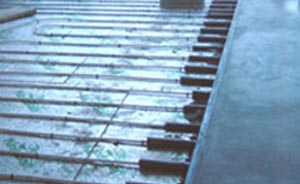
Check any water pipes in your floor for leaks, including underfloor heating.
If no leaks are found, damp and cold patches on your wall might be due to moisture rather than a water leak.
Take a look at our Diagnosing Damp project to work out what kind of damp may be affecting your walls.
After Fixing Water Leaks
After identifying and repairing the water leak, your next step is to address any damage it caused.
This may involve repairing or replacing plaster, paint, wallpaper, and other affected areas.
Removing Black Mould from Water Leak Areas
If you notice black mould on walls or ceilings exposed to a water leak, you may need to remove the plaster down to the wall.
After removing all of the damaged plaster, let the wall dry completely, then treat it with an anti-mould cleaner to eliminate any remaining spores.
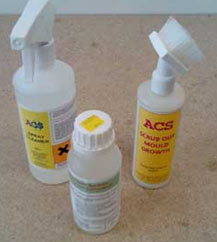
Remove black mould growth caused by leaks with an anti-mould cleaner
After cleaning and drying, replaster the area. To prevent mould from returning, use an anti-mould paint additive or an anti-mould wallpaper paste.
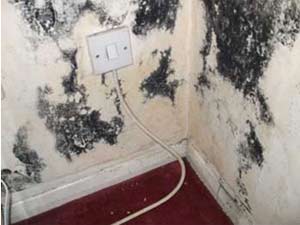
Water coming through your wall can encourage the growth of black mould
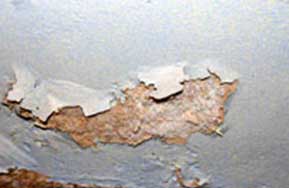
Water leaks can wash salts out of your brickwork and into your plaster
Dealing with Salt Damage in Plaster, Paint, and Wallpaper
If you notice white, crunchy crystals on your plaster, it’s likely salt washed out from your brickwork by the leak. Fixing it depends on your plaster’s condition.
If the plaster is intact, strip off the decoration, let the wall dry, treat it with Salt Neutraliser, and redecorate.
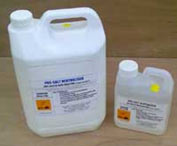
Salt neutraliser prevents salt deposits caused by leaks from returning
If the salts have damaged the plaster, strip it back to the bare wall, let it dry, treat it with Salt Neutraliser, and replaster.
You can use a paint-on or additive neutraliser. Once dry, replaster and redecorate.
For severe salt issues, consider adding a mesh membrane to your wall before replastering. Learn more in our Mesh Membrane Project.
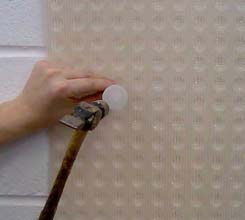
Fitting a mesh membrane can stop salts from appearing in your wall when a water leak is present behind or in the wall
If you have a leak in your home it is highly important that you find the source and fix it as if you don’t this can lead to a whole host of other more expensive and more in-depth issues.

